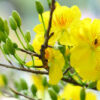**Apricot Blossoms and Traditional Vietnamese Techniques**

Apricot Blossoms hold a special place in Vietnamese culture and are intricately woven into the fabric of traditional artistic techniques. Let’s explore how these cherished flowers intersect with the rich heritage of Vietnamese craftsmanship and artistic expression.
1. **Incorporation into Lacquerware:**
Vietnamese lacquerware is renowned for its exquisite beauty and meticulous craftsmanship, and Apricot Blossoms often feature prominently in these intricate designs. Skilled artisans employ age-old techniques to create stunning lacquer pieces adorned with Apricot Blossoms, using layers of resin, pigment, and eggshell inlays to achieve a glossy, durable finish. These lacquerware items, ranging from decorative trays and vases to furniture and jewelry boxes, showcase the enduring allure of Apricot Blossoms in Vietnamese artistry.
2. **Embroidery and Textile Arts:**
Apricot Blossoms inspire intricate embroidery patterns that adorn traditional Vietnamese garments, tapestries, and household textiles. Talented embroiderers meticulously stitch delicate Apricot Blossoms onto silk fabrics, creating stunning works of textile art that capture the beauty and symbolism of these cherished flowers. Apricot Blossom motifs are often featured in áo dài (traditional Vietnamese dresses), ceremonial robes, and decorative wall hangings, reflecting the timeless elegance of Vietnamese embroidery traditions.
3. **Wood Carving and Sculpture:**
Wood carving is another traditional Vietnamese craft that showcases the beauty of Apricot Blossoms in intricate relief sculptures and decorative motifs. Skilled carvers meticulously carve Apricot Blossoms into wooden panels, furniture, and architectural elements, infusing these pieces with natural elegance and cultural symbolism. Whether adorning temple doors, ancestral altars, or ornate furniture, Apricot Blossom carvings exemplify the mastery of Vietnamese artisans and their ability to capture the essence of nature in wood.
4. **Ceramics and Pottery:**
Apricot Blossoms grace the surfaces of Vietnamese ceramics and pottery, enriching these functional objects with artistic beauty and cultural significance. Ceramic artists draw inspiration from the graceful forms and vibrant colors of Apricot Blossoms to create decorative plates, vases, and teapots adorned with intricate floral motifs. Through traditional techniques such as hand-painting, glazing, and firing, artisans bring Apricot Blossoms to life on clay surfaces, transforming humble vessels into exquisite works of art.
5. **Watercolor Painting and Calligraphy:**
Vietnamese watercolor painting and calligraphy often feature Apricot Blossoms as symbolic motifs that evoke the beauty of nature and the spirit of the Vietnamese countryside. Artists use delicate brushstrokes and vibrant colors to depict Apricot Blossoms in various stages of bloom, capturing their ephemeral beauty and poetic symbolism. Apricot Blossoms are also featured in Vietnamese calligraphy, where they serve as auspicious symbols of prosperity, good fortune, and the arrival of spring.
In summary, Apricot Blossoms are intricately intertwined with traditional Vietnamese techniques, enriching the country’s artistic heritage with their timeless beauty and cultural significance. Whether depicted in lacquerware, embroidery, wood carving, ceramics, or painting, Apricot Blossoms serve as enduring symbols of nature’s grace and the enduring spirit of Vietnamese craftsmanship.
**Preservation and Evolution of Traditional Techniques:**
The integration of Apricot Blossoms into traditional Vietnamese techniques not only celebrates the beauty of nature but also highlights the resilience and adaptability of these age-old crafts. Let’s delve deeper into how these techniques are preserved, adapted, and innovated to ensure the continued legacy of Apricot Blossom artistry.
1. **Cultural Heritage Conservation:**
Traditional Vietnamese techniques, including lacquerware, embroidery, wood carving, ceramics, and painting, are treasured as part of the nation’s cultural heritage. Efforts to preserve and promote these techniques play a vital role in safeguarding Vietnam’s artistic legacy for future generations. Artisan communities, cultural institutions, and government initiatives collaborate to document, research, and transmit traditional techniques, ensuring that knowledge and skills are passed down from master craftsmen to apprentices in accordance with time-honored practices.
2. **Artisan Apprenticeship and Training:**
The transmission of traditional techniques often takes place through informal apprenticeship arrangements, where aspiring artisans learn directly from experienced masters in workshops and ateliers. Apprenticeship programs provide hands-on training, mentorship, and guidance, allowing students to develop proficiency in traditional techniques and gain a deeper understanding of their cultural significance. By preserving the oral tradition and practical skills of craftsmanship, apprenticeship programs contribute to the continuity and vitality of Apricot Blossom artistry.
3. **Innovation and Adaptation:**
While traditional techniques serve as the foundation of Apricot Blossom artistry, artisans also embrace innovation and adaptation to meet contemporary aesthetic preferences and market demands. By experimenting with new materials, tools, and methods, artisans infuse traditional crafts with fresh perspectives and creative expressions, revitalizing age-old traditions for modern audiences. Innovation in design, craftsmanship, and presentation ensures the relevance and sustainability of Apricot Blossom artistry in a rapidly changing world.
4. **Cross-Cultural Exchange and Collaboration:**
Cross-cultural exchange and collaboration provide opportunities for artisans to learn from diverse artistic traditions and incorporate new influences into their work. International workshops, artist residencies, and collaborative projects facilitate dialogue and exchange between Vietnamese artisans and their counterparts from around the world, enriching Apricot Blossom artistry with fresh insights and perspectives. By embracing cultural diversity and embracing global trends, artisans expand the horizons of traditional techniques and foster greater appreciation for Apricot Blossom artistry on the global stage.
5. **Promotion and Market Access:**
Promotion and market access initiatives raise awareness of Apricot Blossom artistry and create opportunities for artisans to showcase their work to a wider audience. Artisan cooperatives, craft fairs, and online platforms provide avenues for artisans to market their products and connect with customers who value traditional craftsmanship and cultural authenticity. By creating demand for Apricot Blossom artistry, these initiatives support the livelihoods of artisans and contribute to the sustainable development of cultural tourism and creative industries in Vietnam.
In summary, the preservation and evolution of traditional Vietnamese techniques ensure the continued vitality and relevance of Apricot Blossom artistry in contemporary society. By embracing innovation, fostering apprenticeship, nurturing cross-cultural exchange, and promoting market access, artisans uphold the rich heritage of Apricot Blossom craftsmanship while embracing the opportunities of the future. Through their dedication and creativity, artisans contribute to the enduring legacy of Apricot Blossoms as symbols of beauty, culture, and artistic excellence in Vietnam and beyond.

